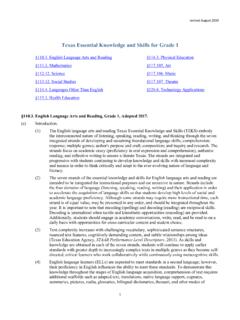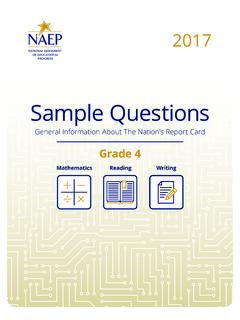Transcription of Psychological Science website. The gender equality …
1 Citation: Stoet, G and Geary, DC (2018) The gender - equality Paradox in Science , Technol- ogy, Engineering, and mathematics Education. Psychol Sci. ISSN 1467-9280 DOI: Link to Leeds Beckett Repository record: Document Version: Article The aim of the Leeds Beckett Repository is to provide open access to our research, as required by funder policies and permitted by publishers and copyright law. The Leeds Beckett repository holds a wide range of publications, each of which has been checked for copyright and the relevant embargo period has been applied by the Research Services team.
2 We operate on a standard take-down policy. If you are the author or publisher of an output and you would like it removed from the repository, please contact us and we will investigate on a case-by-case basis. Each thesis in the repository has been cleared where necessary by the author for third party copyright. If you would like a thesis to be removed from the repository or believe there is an issue with copyright, please contact us on and we will investigate on a case-by-case basis. gender equality Paradox 1. Note: This is an earlier pre-print version. For the final proof-corrected version, please visit the Psychological Science website .
3 The gender equality paradox in STEM education Gijsbert Stoet1 & David C. Geary2. 1) Corresponding author of Social sciences , Leeds Beckett University, Leeds, UK ; 2) Department of Psychological sciences , University of Missouri, Columbia, Missouri Abstract The underrepresentation of girls and women in Science , technology, engineering, and mathematics (STEM) is a continual concern for social scientists and policy makers. Using an international database on adolescent achievement in Science , mathematics , and reading (n =. 472,242), we show girls performed similarly or better than boys in Science in two of every three countries, and in nearly all countries, more girls appeared capable of college-level STEM study than enrolled.
4 Paradoxically, the sex differences in the magnitude of relative academic strengths and pursuit of STEM degrees increased with increases in national gender equality . The gap between boys' Science achievement and girls' reading achievement relative to their mean academic performance was near universal. These sex differences in academic strengths and attitudes toward Science correlated with the STEM graduation gap. A mediation analysis suggests that life-quality pressures in less gender equal countries promote girls' and women's engagement with STEM subjects. Introduction The underrepresentation of girls and women in Science , technology, engineering, and mathematics (STEM) is a world-wide phenomenon (Burke & Mattis, 2007; Ceci, Williams, &.)
5 Barnett, 2009; Ceci & Williams, 2011; Cheryan, Ziegler, Montoya, & Jiang, 2017). Although women are now well represented in the social and life sciences (Ceci, Ginther, Kahn, &. Williams, 2014; Su & Rounds, 2016), they continue to be underrepresented in fields that focus on inorganic phenomena ( , computer Science ). Despite considerable efforts toward understanding and changing this pattern, the sex difference in STEM engagement has remained stable for decades ( , in the USA, National Science Foundation, 2017). The stability of these differences and the failure of current approaches to change them calls for a new perspective on the issue.
6 Here, we identify a major contextual factor that appears to influence women's gender equality Paradox 2. engagement in STEM education and occupations. We find that countries with high levels of gender equality have some of the largesst STEM gaps in secondary and tertiary education; we call this the educational gender equality paradox. For example, Finland excels in gender equality (World Economic Forum, 2015), its adolescent girls outperform boys in Science literacy, and it ranks second in European educational performance (OECD, 2016a). With these high levels of educational performance and overall gender equality , Finland is poised to close the STEM.
7 gender gap. Yet, paradoxically, Finland has one of the world's largest gender gaps in college degrees in STEM fields, and Norway and Sweden, also leading in gender equality rankings, are not far behind (fewer than 25% of STEM graduates are women). We will show that this pattern extends throughout the world, whereby the graduation gap in STEM increases with increasing levels of gender equality . We propose that the educational gender equality paradox is driven by two different processes, one based on distal social factors and the other on more proximal factors. The latter is student's own rational decision making based on relative academic strengths and weaknesses as well as attitudes that can be influenced by distal factors (Figure 1).
8 Figure 1: Schematic illustration of the factors influencing educational and occupational choices. Distal factors, such as relatively poor living conditions might influence the development of personal academic strengths and attitudes toward different academic fields, which in turn result in choices individuals make in secondary education, tertiary education, and occupations. Our proposal that students' own rational decisions play a key role in explaining the gender equality Paradox 3. educational gender equality paradox is inspired by the expectancy value theory (Eccles, 1983.)
9 Wang & Degol, 2013). On the basis of this theory, it is hypothesized that students use their own relative performance ( , knowledge of what subjects they are best at) as a basis for decisions about further educational and occupational choices, and this has been demonstrated for STEM- related decision making in the US (Wang, Eccles, & Kenny, 2013). The basic idea that individuals choose academic paths based on perceived individual strength is reflected in common practice by school professionals: When students have the opportunity to choose their coursework in secondary education, they are typically recommended to make choices based on their strengths and enjoyment ( , Gardner, 2016; Universities and Colleges Admissions Service [UCAS], 2015).
10 Wider social factors may influence engagement in STEM through students' utility beliefs or the expected long-term value of an academic path (Eccles, 1983; Wang & Degol, 2013). The assessment of social factors that might influence STEM engagement is best done comparing countries that vary widely in the associated costs and benefits of a STEM career. One possibility is that contexts with fewer economic opportunities and higher economic risks may make relatively high paying STEM occupations more attractive relative to contexts with greater opportunities and lower risks. This may contribute to the educational gender equality paradox, because economic and general life risks are lower in gender equal countries which in turn results in greater opportunity for individual interests and academic strengths to influence investment in one academic path or another, as demonstrated by Wang et al.




